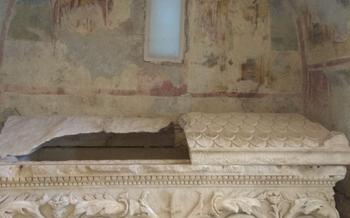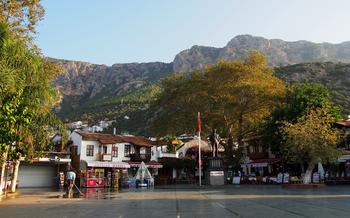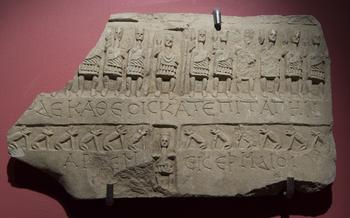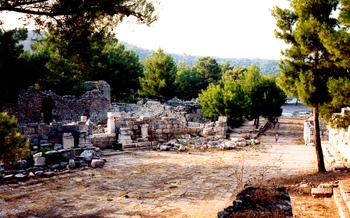
Lycian Rock Tombs in Demre
- A Journey Through Time in Demre's Lycian Rock Tombs
- Location and Getting There:
- Opening Hours and Admission Fees
- Best Time to Visit
- Exploring the Tombs
- History and Significance
- Architectural Features
- Outstanding Examples
- Panoramic Views
- Nearby Attractions
- Facilities and Services
- Practical Tips
- Cultural Sensitivity
- Responsible Tourism at the Lycian Rock Tombs
- Insider Tip: Unveiling Hidden Gems
A Journey Through Time in Demre's Lycian Rock Tombs
In the heart of Turkey's ancient Lycia region, the Lycian Rock Tombs in Demre stand as a testament to a fascinating civilization that once thrived along the Mediterranean coast. These remarkable tombs, carved intricately into the imposing cliffs, offer a glimpse into the rich history, unique burial practices, and artistic legacy of the Lycians.
As you approach the Lycian Rock Tombs, you'll be awed by their sheer size and architectural marvel. These tombs, dating back to the 4th century BC, were meticulously carved into the mountainside, showcasing the exceptional craftsmanship and ingenuity of the Lycian people. Each tomb features a unique facade, adorned with intricate carvings, inscriptions, and reliefs that depict scenes from mythology, daily life, and funerary rituals.
Explore the interiors of these rock-cut chambers to discover a world of symbolism and cultural significance. The tombs often consist of multiple chambers, niches, and burial chambers, each serving a specific purpose in the Lycian funerary customs. Discover how these tombs reflect the Lycians' beliefs in the afterlife, their reverence for their ancestors, and their connection to the divine.
As you wander among these ancient burial grounds, let your imagination transport you back in time to the vibrant Lycian civilization. Picture the Lycian mourners performing elaborate rituals, honoring their departed loved ones, and ensuring their safe passage into the afterlife. Marvel at the artistry and precision of the carvings, each stroke telling a story of a people who deeply valued their heritage and traditions.
Location and Getting There:
The Lycian Rock Tombs are situated in the picturesque town of Demre, nestled along the Mediterranean coast in the Antalya region of Turkey. To reach Demre, visitors have several transportation options at their disposal.
By Bus: For those on a budget or seeking a more local experience, regular buses depart from Antalya and neighboring cities. These buses offer a scenic journey along the coastal roads, allowing passengers to admire the stunning landscapes of the Turkish Riviera.
By Rental Car: Renting a car provides the freedom to explore the region at your own pace and venture beyond the beaten path. Demre is easily accessible by car, with well-maintained roads connecting it to major cities in Turkey.
Organized Tours: For a hassle-free experience, joining an organized tour is a great option. Many reputable tour operators offer day trips or multi-day excursions to the Lycian Rock Tombs, often combined with visits to other nearby attractions. These tours typically include transportation, guided commentary, and entrance fees, ensuring a seamless and informative experience.
Opening Hours and Admission Fees
Planning your visit to the Lycian Rock Tombs in Demre requires some practical considerations. The tombs are typically open to the public daily from 9:00 AM to 5:00 PM, except on Mondays, when they are closed. This schedule may vary during national holidays or special events, so it's advisable to check beforehand.
Admission fees are quite reasonable, making it an affordable attraction for travelers. Adult tickets cost around 125 Turkish Lira, equivalent to approximately $50. Children between the ages of 6 and 12 are entitled to a discounted rate of 75 Turkish Lira (around $75). Students with valid student ID cards can also avail a discounted rate of 90 Turkish Lira (approximately $50).
Keep in mind that these fees are subject to change, so it's always a good idea to check the official website or contact local tourism authorities for the most up-to-date information.
Best Time to Visit
For an optimal experience amidst the Lycian Rock Tombs, timing plays a crucial role. Consider the ideal season, suitable time of day, and strategies to avoid peak tourist hours.
-
Ideal Season:
-
The spring (April-May) and autumn (September-October) offer pleasant weather, fewer crowds, and vibrant landscapes, making them the most suitable seasons to visit.
-
Time of Day:
-
Aim for early mornings or late afternoons to capture the most favorable lighting conditions for photography and enjoy a more tranquil atmosphere with fewer visitors.
-
Avoid Crowds:
-
Steer clear of weekends, public holidays, and the peak tourist season (July-August) to avoid the throngs of visitors and fully immerse yourself in the ancient ambiance.
Exploring the Tombs
The Lycian Rock Tombs are best explored on foot, allowing visitors to immerse themselves in the ancient history and marvel at the intricate details up close. Several walking trails of varying difficulty levels lead to the tombs, providing a scenic and engaging experience.
For those who prefer a more in-depth understanding of the tombs' history and significance, joining a guided tour is highly recommended. Knowledgeable guides provide fascinating insights into the Lycian civilization, their funerary customs, and the symbolism found within the tombs. Guided tours typically cover the most notable tombs, including the Tomb of the Nereids and the Tomb of Amyntas, ensuring visitors don't miss any of the highlights.
For independent travelers, self-guided exploration is also possible. Maps and guidebooks are available at the visitor center, providing detailed information on each tomb. Visitors can take their time to explore at their own pace, capturing the essence of the site without the constraints of a group tour. Whether opting for a guided experience or self-exploration, visitors are sure to be captivated by the Lycian Rock Tombs, a testament to the ingenuity and artistry of an ancient civilization.
History and Significance
The Lycian civilization, known for its unique blend of Anatolian and Greek influences, flourished in the region of present-day Antalya between the 5th and 1st centuries BC. The Lycians were skilled mariners, traders, and artisans, leaving behind a rich legacy of cultural and historical treasures.
Their funerary customs were particularly elaborate, with a strong emphasis on rock-cut tombs. These tombs were not merely burial chambers but also served as testaments to the wealth, status, and achievements of the deceased. The Lycians believed in an afterlife, and their tombs were designed to provide a comfortable and well-equipped dwelling for the departed in the next world.
The tombs are adorned with intricate carvings, inscriptions, and reliefs that offer valuable insights into Lycian mythology, religion, and daily life. These carvings depict scenes from Greek mythology, Lycian legends, and historical events, providing a glimpse into the beliefs and values of this ancient civilization.
Architectural Features
The Lycian Rock Tombs stand as testaments to the remarkable architectural prowess of the ancient Lycians. Their rock-cut facades, carved into the mountainside, showcase a variety of forms and styles, reflecting the diverse artistic traditions of the region. Some tombs feature simple, geometric facades, while others display elaborate and ornate designs, adorned with intricate carvings and reliefs.
Stepping inside the tombs reveals a labyrinth of chambers, niches, and burial chambers, each meticulously crafted to serve its specific purpose. The interior structures exhibit a sophisticated understanding of engineering and architecture, demonstrating the Lycians' ability to create complex and durable structures without the use of advanced tools.
The Lycians' architectural ingenuity is evident in the construction of these tombs. They employed a combination of techniques, including carving, chiseling, and sculpting, to create structures that have withstood the test of time. The tombs' placement on the mountainside allowed for natural drainage and ventilation, ensuring the preservation of the remains within.
These architectural marvels stand as a testament to the skill, creativity, and engineering prowess of the ancient Lycians. Their rock-cut tombs continue to captivate visitors with their grandeur, beauty, and enduring legacy.
Outstanding Examples
Among the numerous Lycian rock tombs in Demre, several stand out for their exceptional architectural features and historical significance. The Tomb of the Nereids is an iconic example of Lycian rock-cut architecture, dating back to the 4th century BC. Its intricately carved facade features a frieze depicting Nereids, mythical sea nymphs, riding on sea creatures. The tomb's interior is equally impressive, with chambers adorned with delicate reliefs and paintings.
Another notable tomb is the Tomb of Amyntas, dating back to the 3rd century BC. Known for its well-preserved facade, the tomb features a Doric-style portico supported by four Ionic columns. The interior consists of a single chamber with a burial niche and a relief depicting Amyntas, the governor of Lycia, seated on a throne.
Other notable tombs in the area include the Painted Tomb, known for its colorful frescoes depicting scenes from Greek mythology, and the Tomb of Harpy, featuring a frieze with mythical Harpy creatures carrying off human souls. These tombs offer a glimpse into the artistic and cultural achievements of the Lycian civilization.
Panoramic Views
The Lycian Rock Tombs offer breathtaking panoramic views of the surrounding landscape, making them a photographer's paradise. From the elevated vantage point of the tombs, visitors can capture stunning vistas of the sparkling Mediterranean Sea, framed by the majestic Taurus Mountains. The interplay of colors during sunrise and sunset creates a magical ambiance, transforming the scene into a picturesque masterpiece. Whether you're an avid photographer or simply someone who appreciates natural beauty, the panoramic views from the Lycian Rock Tombs are not to be missed. Be sure to bring your camera and capture the unforgettable moments of your visit.
Nearby Attractions
Beyond the Lycian Rock Tombs, Demre offers a wealth of historical and natural wonders waiting to be explored. Embark on a journey to the ancient city of Myra, just a short distance from the tombs. Step into the past as you wander through its impressive ruins, marvel at the well-preserved theater, and discover even more rock-cut tombs that tell tales of ancient civilizations.
Demre holds a special place in the hearts of many as the birthplace of Santa Claus. Visit the Church of St. Nicholas, believed to be the final resting place of this beloved figure. Immerse yourself in the legends and stories that surround this iconic saint and experience the magic of Christmas in this enchanting town.
For those seeking a unique island adventure, hop on a boat and set sail to Kekova Island. Discover a breathtaking world of sunken ruins, where ancient structures lie beneath the crystal-clear waters, inviting you to explore the depths of history. The island's picturesque landscapes, dotted with charming villages and hidden coves, will leave you captivated.
Facilities and Services
The Lycian Rock Tombs offer a range of facilities and services to enhance visitors' experience and understanding of the site. A modern visitor center is conveniently located near the entrance, providing comprehensive information about the history, architecture, and cultural significance of the tombs. Helpful staff is on hand to answer questions, provide maps, and offer guidance to ensure visitors make the most of their visit.
Guided tours are available in various languages, led by knowledgeable local experts who share fascinating insights into the tombs' history, symbolism, and architectural features. These tours provide a deeper understanding of the Lycian civilization and its unique burial practices, bringing the ancient world to life.
For the comfort of visitors, restrooms are available on-site, ensuring convenience during their exploration. Additionally, there are refreshment options, such as a café or snack bar, where visitors can relax and enjoy light refreshments while admiring the stunning views of the surrounding landscape.
Practical Tips
Sun Protection: When visiting the Lycian Rock Tombs, it's essential to protect yourself from the intense Mediterranean sun. Bring sunscreen with a high SPF, a hat to shield your face and neck, and sunglasses to protect your eyes.
Comfortable Footwear: The terrain around the tombs can be uneven, and you'll likely do a fair amount of walking on trails. Therefore, comfortable walking shoes or sandals are highly recommended. Avoid flip-flops or high heels, as they can be hazardous on uneven surfaces.
Bring Water: While there are no water sources on-site, there are vendors selling refreshments near the entrance. However, it's always advisable to bring your own water bottle, especially during hot weather. Stay hydrated to enjoy your exploration without succumbing to dehydration.
Cultural Sensitivity
As you explore the Lycian Rock Tombs, it is essential to be mindful of the cultural and historical significance of the site. Remember that these tombs are not just ancient ruins but also sacred places for the Lycian people. Show respect by avoiding inappropriate behavior, such as climbing on the tombs or touching the reliefs. When taking photos, be considerate of other visitors and seek permission before photographing people. By respecting the cultural heritage of the Lycian Rock Tombs, you help preserve this unique and awe-inspiring site for future generations.
Responsible Tourism at the Lycian Rock Tombs
As a responsible traveler, it's essential to prioritize sustainable practices and ethical behavior when exploring the Lycian Rock Tombs. Avoid littering and use eco-friendly transportation options to minimize your environmental impact. Support local businesses and artisans by purchasing souvenirs and handicrafts, contributing to the preservation of traditional skills and the local economy.
Remember that the Lycian Rock Tombs are a priceless part of Turkey's rich cultural heritage. By adhering to responsible tourism principles, you can help protect and preserve these ancient treasures for future generations to appreciate and enjoy.
Insider Tip: Unveiling Hidden Gems
Venture beyond the main tourist trails to discover the hidden gems among the Lycian Rock Tombs. Explore the less-frequented tombs situated further away from the crowds, where you can immerse yourself in the tranquility and authenticity of these ancient burial sites. These hidden treasures offer a unique opportunity to connect with the past and gain a deeper appreciation for the Lycian civilization. Discover intricate carvings, awe-inspiring facades, and panoramic vistas that will leave you spellbound. Embrace the serenity and solitude as you wander through these ancient corridors of time, creating lasting memories of your journey to the Lycian Rock Tombs.









